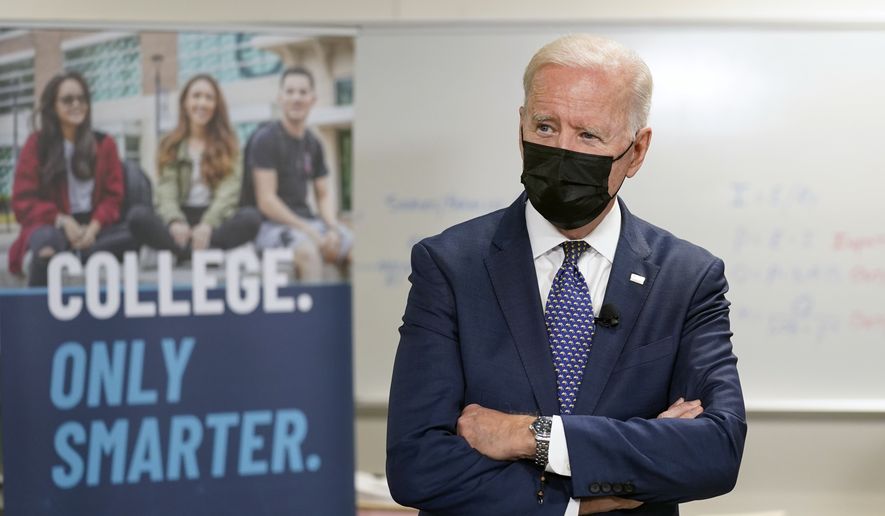President Biden wants his supersized Obamacare subsidies to last forever, proving his push to inject cash into the program was not so much a balm for pandemic pains as a push to fix glaring affordability gaps in the 2010 law.
Democrats raised Obamacare subsidies for private insurance across the board and lifted the income cap on assistance for two years as part of their $1.9 trillion COVID-19 relief bill.
The White House budget office hailed the move as a way to lower health care costs and expand access during a “once-in-a century pandemic,” though Obamacare critics and supporters alike said Mr. Biden was unlikely to give up the sweetener once the pandemic subsided.
They were right.
Mr. Biden wasted no time in telling Congress to make the benefit permanent, a move that would cost an estimated $200 billion over 10 years and stave off a politically painful situation when the benefits expire after 2022.
“The American Rescue Plan lowered health care premiums for 9 million Americans who buy their coverage under the Affordable Care Act. Let’s make that provision permanent so their premiums don’t go back up,” Mr. Biden said in an address to a modified joint session of Congress last week.
The swift call for long-lasting help from Uncle Sam drew a standing ovation from House Speaker Nancy Pelosi, California Democrat, and hackles from congressional Republicans, who said the idea papers over economic flaws in the law.
“Democrats want to spend another $200 billion on Obamacare instead of focusing on actual bipartisan solutions. This has nothing to do with ending the pandemic. This is about Democrats ramming through as many of their partisan priorities as possible,” said Sen. John Barrasso, Wyoming Republican. “Republicans support lowering the cost of health care for all patients, not wasting billions to permanently prop up this failed program.”
Obamacare insures about 20 million people through federally subsidized private insurance and expanded Medicaid eligibility. Yet many Americans remain priced out of coverage or ineligible for government-funded insurance in states that refused to expand their Medicaid rolls under Obamacare, leaving the program far short of its goal of universal coverage.
Mr. Biden is hoping increased subsidies will burnish Obamacare’s legacy.
The American Rescue Plan, which Mr. Biden signed in March, made people earning over 400% above the poverty line eligible for subsidies for the first time. It removed the income cap and offered financial help if “benchmark” premiums exceeded 8.5% of income.
Health care analysts say boosting subsidies as a form of temporary relief made sense because people who use Obamacare are often between jobs or are self-employed. Those folks have endured disproportionate harm from the pandemic.
“It’s also true this is something that Democrats have been wanting for years,” said Cynthia Cox, a vice president and director for the Affordable Care Act program at the Kaiser Family Foundation, a nonprofit health care policy organization.
The push to make sure those benefits don’t expire has been overshadowed by big-ticket items such as universal pre-kindergarten, free tuition at community college and expanded family leave. Mr. Biden highlighted those provisions of the $1.8 trillion American Families Plan during a stop Monday in Virginia.
Mr. Biden had to shoehorn the temporary subsidy boost into a fast-track process called “budget reconciliation,” which averts a Senate filibuster. He might have to resort to the tactic again to navigate a 50-50 split in the chamber, plus centrist Democrats who are wary of passing another round of trillion-dollar spending without Republican votes.
“I thought they would wait until early 2022 to try to make [the subsidies] permanent,” said Brian Blase, who was an economic adviser to President Trump and now a senior fellow at the Galen Institute. “I think the temporary boost was probably because anything more than a two-year boost didn’t seem COVID-related.”
The White House is framing the push for permanent subsidies as part of a series of ambitious, big-spending bills that Mr. Biden is pitching with narrow Democratic majorities in Congress.
“The biggest improvement in health care affordability since the Affordable Care Act, the American Rescue Plan provided two years of lower health insurance premiums for those who buy coverage on their own, saving families an average of $50 per person per month,” a White House fact sheet says. “The American Families Plan will make those premium reductions permanent, a $200 billion investment.”
Citing estimates from the Urban Institute, it says 9 million customers will save hundreds of dollars per year on their premiums and that 4 million people will gain coverage as they are enticed into the Obamacare marketplace.
“It kind of gets at the fundamental criticisms of the ACA,” Ms. Cox said. “We’ve been hearing a lot over the years about high premiums and high deductibles. That’s particularly true for a relatively small group of middle- and upper-income people who’ve been priced out of the ACA market.”
Making the bigger subsidies permanent would eliminate that issue. It also explains why Mr. Biden is moving so soon after a two-year fix under the pandemic framing.
“If these subsidies expire, you’ll start hearing about premium increases right before the ’22 midterm elections,” Ms. Cox said. “They’re trying to work with the political momentum they have.”
• Tom Howell Jr. can be reached at thowell@washingtontimes.com.




Please read our comment policy before commenting.